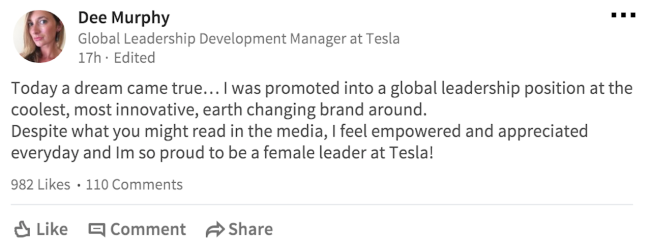Random. [It’s Friday of another long short summer week. We hope sales go well for you this weekend, and that you’re staying on schedule and on budget during the week-days].
I read a LinkedIn post “liked” by a friend, and it got me thinking about one of our business community’s devilish challenges.
Briefly, the post reads:
Today a dream came true… I was promoted into a global leadership position at the coolest, most innovative, earth changing brand around. Despite what you might read in the media, I feel empowered and appreciated everyday and Im so proud to be a female leader at Tesla!
It’s from Dee Murphy, global leadership Development Manager at Tesla.

In the same instant, Tesla is again making news announcing it will team with a French energy company Neoen to build the world’s largest–129MWh–lithium battery to store renewable energy in South Australia.
And this has exactly what to do with our daily ruminations here for home builders in the dirt of these United States?
Might the answer be “everything?”
What is the delta measuring the increment of time and change needed to see such a post from an individual in the home building and residential development business? A dream-come-true job at a game-changing company–that’s pretty rare.
Now, let’s flash back to the present, where we’re hearing about one of new residential construction’s acute and chronic problems, the skilled labor shortage.
A little over a couple of months back, we wondered “Why Don’t Young Americans Want to Do Construction Work?” and we saw data that showed that, while “good pay” matters to those who do choose the field, compensation alone falls short as an attraction among those considering home building among other options. Many young adults in our great nation would not pick home building as a career for any amount of money.
Now, here’s an incisive view on one of the underlying challenges the business community faces, which is to attract more better talent into the field. Brian Saab, founder of Seattle-based construction technology consultancy Unearth, writes of the field’s “image” problem. He notes:
Unfortunately, construction is also caught in a negative cycle. Its poor public image prevents it from attracting fresh, innovative talent; and its lack of fresh, innovative talent prevents it from changing its image. The cycle needs to be broken before construction can more forward.
By making construction appeal to bright, young talent, the industry can boost its embrace of technology and reverse its productivity decline, escaping this trap.
Saab offers a thorough, well-thought out, programmatic, and actionable approach to fix construction’s image among those who’d consider it as a career option.
One issue, though, is that a construct that views Architecture, Engineering, and Construction (AEC) as neatly divisible means of dividing and conquering job descriptions may, in fact, be at the root of the challenge.
Why would a smart individual choose to pay the price of learning a set of skills he or she knows will 1. be subject to severe cyclical dislocation, and 2. almost certainly be doomed for replacement by robots, or artificial intelligence, or some combination of sensors, microchips, and claws? Maybe a fusion of the three, architecture-engineering-construction, would strike a smart person seeking a dream-come-true opportunity as both future-proof and energizing. Tomorrow’s labor force will have built-in capacity to renew, upgrade, and evolve skills as economic cycles and seismic shifts demand.
That transforms what we regard as labor today to talent. It’s a force that learns to learn as it creates value.
Back to the original question. How can the business attract the kind of people, like Dee Murphy above, who’d regard the what, and the why, and the who-for of her or his assignment a dream job?
Seriously.
Would it not begin by seeing today’s “construction labor shortage” as an issue framed by a relatively short-term horizon–at least in the sense of having, say, a sufficient quantity of semi-skilled workers in any given trade to keep costs for that aspect of construction both predictable and controlled?
If home building had more Dee Murphys, would it have as much anxiety as it does over shortages of framers, or dry wall crews, or finishing trades?
In other words, which is the bigger pain point in the business right now, talent or labor? Or, if the right talent were entering the field, attracted by the “job” of housing as a dream job, would we be talking about an unending crisis related to a shortage of workers?
This is an issue central to our Hive conversation, which incubates new solutions from fresh perspectives from non-traditional players committed to solving housing’s present challenges to open a wider path for homes and communities of the future.
Have a look at what we’re up to in our plans for Hive 2017, Trust and Transformation: How Innovation Works.



